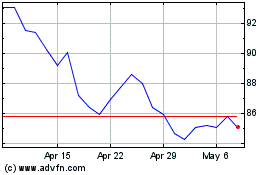Edwards Launches the SAPIEN 3 Ultra RESILIA Valve in Europe With Technology to Enhance Durability
May 08 2024 - 7:21PM
Business Wire
Edwards Lifesciences today announced the European launch of the
SAPIEN 3 Ultra RESILIA valve, the only transcatheter aortic heart
valve to incorporate the company’s breakthrough RESILIA tissue
technology, designed to extend the valve’s durability.*
Edwards’ SAPIEN 3 Ultra RESILIA valve recently received CE Mark†
for use in patients with heart valve disease due to native calcific
aortic stenosis at all levels of surgical risk or due to the
failure of either a transcatheter or a surgical bioprosthetic valve
who are judged to be at high or greater risk for open surgical
therapy.
“Today’s patients are living longer, more active lives, with
high expectations for their health and quality of life, so lifetime
management of heart valve disease, starting with the first valve,
is increasingly important,” said Flavio Ribichini, professor of
cardiovascular medicine at the University of Verona. “SAPIEN 3
Ultra RESILIA gives these patients a promising option, as RESILIA
tissue’s calcium-blocking technology addresses structural valve
deterioration, one of the primary causes of reintervention
following heart valve replacement.”
Edwards RESILIA is a bovine pericardial tissue treated with
advanced anti-calcification technology that provides the potential
to extend the durability of the SAPIEN 3 Ultra RESILIA valve.*
RESILIA tissue is already used in the world’s leading surgical
aortic valve, the Edwards INSPIRIS RESILIA valve. Recent data on
the RESILIA tissue from the 7-year COMMENCE Study showed
encouraging results with low rates of structural valve
deterioration (99.3% freedom from structural valve deterioration),
clinically stable gradients and freedom from reoperation
(97.2%).‡
“RESILIA tissue is the result of nearly 20 years of research and
development and is a prime example of Edwards’ continued focus on
delivering technology that puts patients first,” said Gregory
Servotte, senior vice president of transcatheter heart valves EU at
Edwards Lifesciences. “Latest data emphasize the value of RESILIA
tissue in the lifetime management of valve disease.ठThe SAPIEN 3
Ultra RESILIA valve utilizes this technology with the aim of
improving quality of life, offering sustainable long-term patient
outcomes and making future treatment options possible.”
In addition to its anti-calcification properties, RESILIA tissue
allows the valve to be stored under dry packaging conditions,
facilitating ease of use. Today, the SAPIEN 3 Ultra RESILIA valve
is the only transcatheter heart valve on the market with dry tissue
storage.
At Cardiovascular Research Technologies (CRT) 2024, Dr. Curtiss
Stinis presented compelling results from a large, real-world study
(10,314 patients), based on US TVT Registry data that demonstrated
continued excellent outcomes for patients treated with the Edwards
SAPIEN valve platform. A study of the SAPIEN 3 Ultra RESILIA valve
found lower rates of paravalvular leak (PVL) at 30 days, lower
echo-derived gradients and larger effective orifice areas across
all valve sizes when compared to the SAPIEN 3 and SAPIEN 3 Ultra
valves.
Notes to Editors
* De La Fuente AB, et al. Advanced Integrity Preservation
Technology Reduces Bioprosthesis Calcification While Preserving
Performance and Safety. J Heart Valve Dis. 2015
Jan;24(1):101-9.
† The Edwards SAPIEN 3, SAPIEN 3 Ultra, and SAPIEN 3 Ultra
RESILIA transcatheter heart valve system is indicated for use in
patients with heart disease due to native calcific aortic stenosis
at any or all levels of surgical risk for open heart surgery. The
Edwards SAPIEN 3, SAPIEN 3 Ultra, and SAPIEN 3 Ultra RESILIA
transcatheter heart valve system is indicated for patients with
symptomatic heart disease due to failure (stenosed, insufficient,
or combined) of an aortic transcatheter bioprosthetic or surgical
aortic or mitral bioprosthetic valve who are judged by a heart
team, including a cardiac surgeon, to be at high or greater risk
for open surgical therapy (i.e., predicted risk of surgical
mortality ≥ 8% at 30 days, based on the Society of Thoracic
Surgeons (STS) risk score and other clinical co-morbidities
unmeasured by the STS risk calculator).
‡ Beaver T, Bavaria J, Griffith B, et al. Seven-Year Outcomes
Following Aortic Valve Replacement with a Novel Tissue
Bioprosthesis. J Thorac Cardiovasc Surg. 2023 Sep
29:S0022-5223(23)00873-5.
§ Stinis CT, Abbas AE, Teirstein P, et al. Real-World Outcomes
for the Fifth-Generation Balloon Expandable Transcatheter Heart
Valve in the United States. JACC Cardiovasc Interv. 2024 Apr
22;17(8):1032-1044.
No clinical data are available to evaluate the long-term impact
of RESILIA tissue in patients. Additional clinical data for up to
10 years of follow-up are being collected to monitor the long-term
safety and performance of RESILIA tissue.
About Edwards
Lifesciences
Edwards Lifesciences is the global leader of patient-focused
innovations for structural heart disease and critical care
monitoring. We are driven by a passion for patients, dedicated to
improving and enhancing lives through partnerships with clinicians
and stakeholders across the global healthcare landscape. For more
information, visit Edwards.com and follow us on LinkedIn and X.
Edwards, Edwards Lifesciences, the stylized E logo, Edwards
SAPIEN, Edwards SAPIEN 3, Edwards SAPIEN 3 Ultra, Edwards SAPIEN 3
Ultra RESILIA, Edwards INSPIRIS RESILIA, INSPIRIS RESILIA,
INSPIRIS, RESILIA, SAPIEN, SAPIEN 3, SAPIEN 3 Ultra, and SAPIEN 3
Ultra RESILIA are trademarks of Edwards Lifesciences Corporation.
All other trademarks are the property of their respective
owners.
View source
version on businesswire.com: https://www.businesswire.com/news/home/20240508195367/en/
Media Contact: Rowan Unsworth, +41 (0)79 564 20 82,
rowan_unsworth@edwards.com
Edwards Lifesciences (NYSE:EW)
Historical Stock Chart
From Apr 2024 to May 2024

Edwards Lifesciences (NYSE:EW)
Historical Stock Chart
From May 2023 to May 2024
